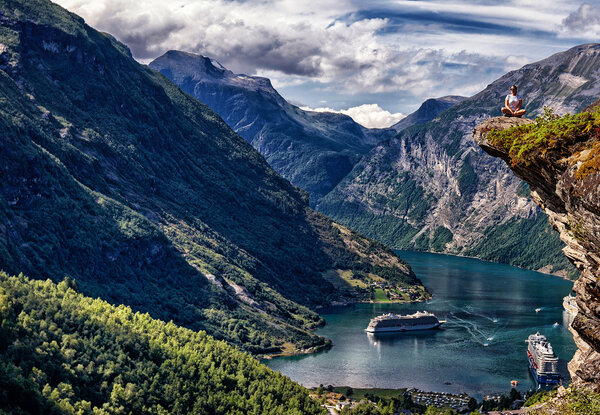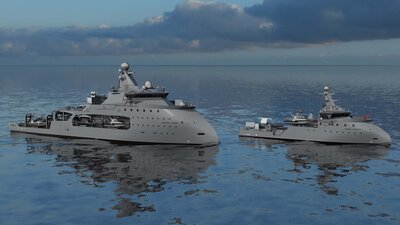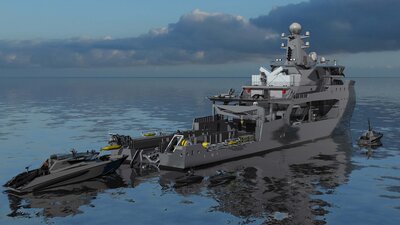When visiting vulnerable or protected areas particular care must be taken. In protected areas like the Geiranger fjord, cruise emissions can have a substantial effect on the overall emissions, reaching 80% during summer days. Ulstein provides a solution in which emissions are diminished, and even locally eliminated, for cruise day operations.
By increasing the focus on lean energy consumption, from the ship systems and the guests, and combining systems and methods such as power management, renewable energy sources, energy storage and heat recovery, together with the right training and engagement of crew and passengers on-board, operations with zero emissions can be achieved.
DEVELOPED FOR OPERATOR'S NEEDS
All operators have their specific needs. An ULSTEIN ZED? solution must be adapted to the owner's situation, the route and the needs of the passengers. Some joint features must nonetheless be installed to achieve one-day of zero emissions, these include an energy recovery and HVAC management system, a battery energy storage system, a solar energy system, hot water storage and a modern automation system with cloud service possibilities.
To develop the right solution, Ulstein will analyse the operational needs of the vessel in close cooperation with the owner and establish an operational profile. After this, Ulstein will start to find the best solutions for hull and propulsion, energy recovery, auxiliary systems, energy storage and alternative energy sources. Both vessel and operation are developed and planned as one.
ZERO EMISSIONS POSSIBLE THROUGH CAREFUL SCHEDULING
The overall goal has been to ensure the vessel's 12-hour operations without emissions to air or water, using currently commercially viable and available technology. To reach the goal, Ulstein developed the following operation philosophy for the vessel: A cultural change where lean energy consumption when in vulnerable areas is accepted, produce and store energy when in transit or in port if shore connection is available, incorporate clean fuel/energy sources.
The day schedule when visiting vulnerable areas must be carefully planned to achieve zero emissions. When entering the area, the vessel needs to switch to battery power. In this mode, emissions are eliminated, and noise levels and vibrations are negligible. When the destination is reached, anchor will be dropped. Passengers will go for excursions on small tenders. After the passengers have returned to the mother vessel, it will depart the area on battery power. Power consuming activities such as hot meals, laundry and cleaning will be reduced to a minimum while staying in vulnerable areas. In addition to battery power all showering and hot water activities should use hot water produced and stored in transit, and the vessel can utilise other means of energy sources such as solar energy. These measures will also contribute to overall cleaner and smarter year-round operations.
PRIORITY 1 - REDUCE ENERGY CONSUMPTION
Lean energy consumption is key to reach zero emission operations. Thus, it should be executed a thorough analysis of the activities on board the ship and based on the objective it must be decided what energy consumption is acceptable. In addition, we must introduce smart control systems for air condition and energy management, based on and adjusted to the operational patterns of galley, laundry and other common areas. Further, engagement of passengers and crew members will also contribute to a more efficient use of energy on board. The adjustment of vessel speed will not only contribute to lower energy consumption, but also to create less footprint on the area, such as lower wake wash, lower coast erosion and less noise.
PRIORITY 2 - STORE ENERGY WHEN IN TRANSIT
In order to operate with battery power, the vessel need to charge the batteries with extra energy while operating outside vulnerable areas. There are several methods of preserving energy use for hot water, electrical consumption and more. Energy production can be achieved by solar panels, minimum energy consumption by the most efficient hull and power systems such as the main generator sets, energy recovery by reusing waste heat, and energy storage through battery systems.
PRIORITY 3 - CLEAN FUEL
Solar and wind power are clean energy sources, as well as reusing waste energy. Marine gas oil replaces heavy fuel oil by default, and alternative fuel sources are evaluated based on the operational needs of the vessel. Ulstein is also working with integration of fuel cell technology utilizing hydrogen (H2) or liquified natural gas (LNG) with dual fuel engines, complementing a battery hybrid power system.
THE EXPLORERS' PARTICIPATION
The ULSTEIN ZED solution is most successful when operators and passengers share a joint awareness and holistic thinking, where technology supports culture. This can be achieved by on-board lectures and competitions.
AN INVESTMENT FOR THE FUTURE
The ULSTEIN ZED set-up is not only for use on one-day missions to vulnerable areas. When batteries and other means of power sources are firstly installed on the vessel, a systematic use of the solutions can lead to a significant reduction of running hours of main engines and fuel consumption.



